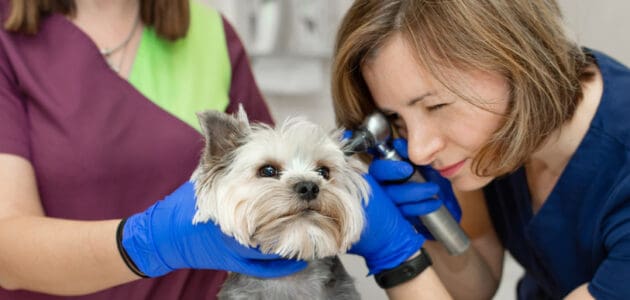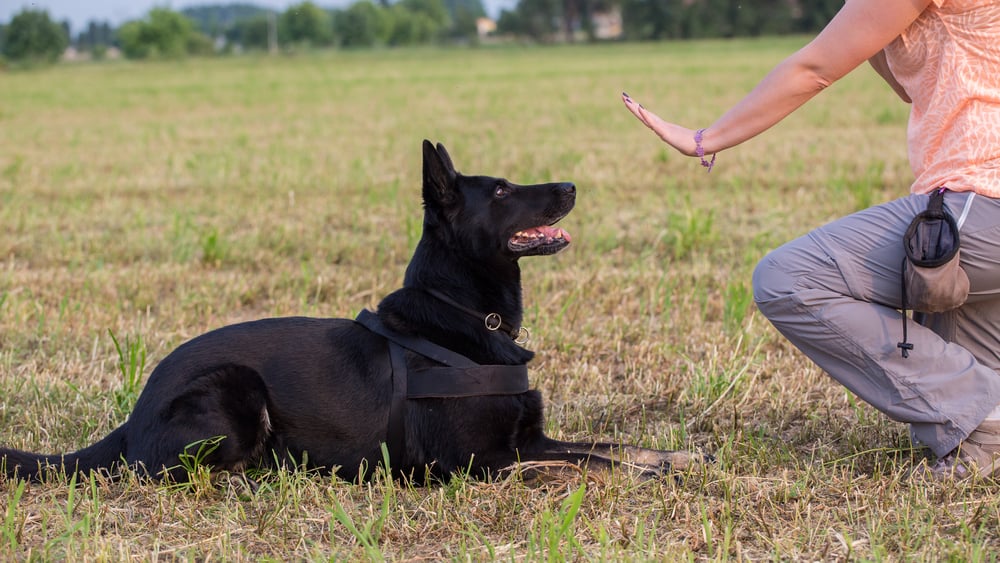You Hear That, Boy? How to Tell if Your Dog Is Deaf

You’ve just finished preparing your furry friend’s favorite meal. You wait eagerly, knowing the sound of food pouring into the bowl would have awoken them from their slumber, and at any moment you’ll get to hear the adorable sound of their enthusiastic paws scrambling across the house.
You wait and listen. But a minute passes. And then another. You lift up the bowl, shake it, and wait again. But still, you hear no paws pattering. After waiting some more, you finally go to search for your pup.
To your surprise, your pooch isn’t busy playing outside, nor are they deeply snoozing away in the bedroom. Instead, they’re sat in the hallway, only a short distance from the kitchen, looking at you blankly. Now the anxiety creeps in, and you’re left questioning your fur baby’s once impeccable hearing.
All You Need to Know About Canine Hearing Loss
Realizing your dog might be experiencing hearing loss can be nerve-wracking. But don’t worry, we’re here to help. In this in-depth guide, we’ll be going over all you need to know about deafness in dogs, including how to tell if your dog is deaf.
We’ll also be covering how to care for a dog with hearing loss, so you can rest assured if your pooch is deaf, you’ll know how to provide them with the best support moving forward.
What Causes Deafness in a Dog?
Approximately 5 to 10 percent of dogs in the United States experience some degree of hearing loss. Depending on the cause, deafness can happen abruptly or gradually. Just like humans, some dogs are born deaf, and they can be deaf in one ear (unilateral) or both ears (bilateral). There are two types of deafness: congenital and acquired.
Congenital Deafness
Congenital deafness is the term for hearing loss present at birth. It is caused by either genetic inheritance or a birth defect. Some breeds are more prone to congenital deafness than others, such as the Boston Terrier, Cocker Spaniel, and Dalmatian. In fact, a phenomenal 30 percent of Dalmatians are born with hearing loss.
Although it’s not clear why, we know that dogs with piebald, white, or merle coats are also more susceptible to congenital deafness—this is likely why Dalmatians are so prone to it.
Acquired Deafness
Acquired deafness is hearing loss that develops later in life. Acquired deafness can be caused by a whole range of things, including trauma, exposure to loud sounds, tumors, ear inflammation (otitis externa), and drug toxicity.
A blockage in the ear, whether from excessive wax buildup or trapped debris, can also cause hearing loss, though often this deafness is only temporary, and hearing will return after the blockage has been dealt with.
Senior dogs are particularly prone to acquired deafness due to nerve degeneration. This age-related hearing loss happens very gradually, so it can be hard to spot straight away.
Signs Your Dog Is Deaf
Here, we’ll go over the telltale signs of hearing loss in dogs. Keep in mind that these signs can be caused by other conditions as well, like canine senility, so it’s always important to test your dog’s hearing (we’ll go over the process later on) and speak to a veterinarian.
Less Anxious Over Noise
If your furry friend previously had a vendetta against the vacuum cleaner, and they now sleep soundly in its presence, hearing loss is likely the cause. When a dog stops reacting to noises they had a problem with in the past, it’s not because they’ve miraculously become unbothered by them; it’s usually because they simply can’t hear them.
After all, the vacuum cleaner seems a lot more friendly (and less scary!) if it doesn’t constantly let out a deafening whirr.
Excessive Barking
If your dog has lost their hearing, they may bark louder and more excessively; they can no longer tell how noisy they’re being, and not being able to hear can be frustrating and stressful at times.
Disobedience
Has your typically well-behaved pooch suddenly begun to disobey commands? It could be because they just can’t hear the commands you’re giving them. This is especially true if your dog’s disobedience occurs most often when they’re not looking at you.
Other Signs to Look For
- Startles easily (as they’re unable to hear things approaching them)
- Not responding to their name being called
- Sleeping more deeply, loud noises not waking them up
- Not as active
- Disinterest in what’s going on around them
- Shaking or tilting their head
- Withdrawing from social interaction
Signs Your Puppy Is Deaf
It’s a little more difficult to tell if a puppy is deaf; not responding to commands, or ignoring your calls, could just be the result of their easily distracted and stubborn temperament. However, there are ways to tell if your puppy is deaf, and spotting their deafness early will mean you can give them the best start in life.

- Biting hard; inability to tell that their biting is hurting littermates
- Ears not twitching or flicking in response to noise
- Not responding to squeaky toys
- Not waking up for food, or being the last to eat
- Difficulty learning verbal commands
Newborns
Keep in mind that you won’t be able to tell if a newborn puppy has a hearing ailment. All puppies are born deaf, and their hearing doesn’t fully develop until they’re about two weeks old.
How to Test Your Dog’s Hearing
If you believe your dog is suffering from a hearing ailment, you can test their hearing with the methods below.
The Clapping Test
Wait until your furry friend is settled, then slowly approach them from behind.
Clap your hands once or twice, then wait to see if your dog reacts. If they don’t react, clap again, but this time louder. A dog without hearing difficulties will respond to the sudden noise, and they’ll be able to immediately pinpoint where the sound is coming from.
If your dog has hearing loss, they’ll not respond to the sound whatsoever (fully deaf), or they’ll respond to the noise but have difficulty figuring out where it’s coming from (partially deaf).
After you have finished the clapping test, you can repeat the process with sounds of different volumes and pitches; you could ring a bell, play the radio or blow a whistle. Doing so will give you a much better picture of whether your dog is deaf, and if they are, the extent of their deafness.
Additional Tips
When you approach your dog, make sure there’s some distance between you both. If you stand too close, they could detect your presence in other ways; they could pick up the vibrations from your steps, or they could smell you, especially if you’re wearing perfume or aftershave!
Make sure to also test your pup’s hearing with sounds they’re likely to react to. For example, you could shake their favorite packet of treats. You might find that they’re just ignoring the sounds that don’t interest them!
Call Their Name
Another way to test your dog’s hearing is by calling their name when they’re not looking at you. If your dog can hear your voice, their ears will twitch in response to the sound, and they will either look toward you immediately or come to you.
If your dog does not display this behavior, they are likely deaf or partially deaf. If your dog is partially deaf, they will struggle to locate where you are.
Assess Their Behavior During a Walk
If your dog is deaf, they may exhibit the following behavior during a walk:
- Repeatedly looking back toward you, rather than focusing on what’s ahead
- Staying closer to your side, not wanting to walk too far from you
- Not noticing approaching vehicles
Speaking to Your Veterinarian
If you’re still concerned about your pup’s hearing after these tests, you should take them to a veterinarian as soon as possible. It’s vital you speak to a veterinarian for two reasons. Most obviously, they will be able to confirm your diagnosis (usually with a BAER test, which we talk about below).
However, the other reason is that your dog’s deafness could be caused by an underlying medical problem, infection, or obstruction in the ear—all things that require veterinary care.
The BAER Test
The Brainstem Auditory Evoked Response test, or BAER for short, is the most effective way of testing for deafness. It can even determine the extent of hearing loss. The BAER test is a non-invasive procedure, and it won’t be painful for your pooch.
Keep in mind that the BAER test is fairly expensive, and it can only be conducted on dogs older than five weeks. As the BAER test requires specialized equipment, your local veterinarian may not be able to conduct the test. If this is the case, you can ask your veterinarian for a referral to a practice that is able to do the test.
The Orthopedic Foundation for Animals (OFA) provides further details about the testing process.
Looking After a Deaf Dog
Your deaf companion can live as much of a happy, healthy, and fulfilling life as a hearing dog can. Dogs are highly adaptive, and deafness won’t slow them down. Instead, they’ll learn to rely on their other senses to understand the world around them. That said, you will need to take some extra measures to ensure they stay safe.
Keeping a Deaf Dog Safe
As we mentioned earlier, deaf dogs tend to startle more easily than hearing dogs. As such, avoid sudden touches and movements, and don’t approach them from behind. You can help your dog become more accustomed to sudden touches with appropriate training.
Waking Your Pooch
If you need to wake your furry friend up, make sure to do so gently and slowly. Avoid touching them on their face, as if your dog does get startled, they may lash out. The best place to touch them is their hind legs.
Safe and fun ways to wake your dog include stomping near them (they can feel the vibrations) or putting a treat in front of their nose – the mouthwatering smell will most certainly get your dog up from their slumber!
Use Tags, Patches, and Bells
You could also buy an “I’m deaf” tag for their collar and a “Deaf Dog” patch for their leash. This will let others know your dog won’t respond to verbal cues, and it’ll help to prevent passersby from petting them without asking you first. It’s also a good idea to add bells to your dog’s collar. The noise will make it easy to hear where they are.
Use a Leash & Harness
When walking your dog, it’s vital you keep them on a short leash, especially in high traffic areas. Your dog won’t be able to hear approaching vehicles, nor will they be able to hear a sudden warning to back off. It’s also important you invest in a harness. A harness will give you much greater control over your pup.
Escape-Proof Your Home
Last but not least, ensure your yard is escape-proof, and supervise your dog when they are in the yard.
For more tips on how to care for a deaf dog and keep them safe, we recommend Susan Cope Becker’s handy book, Living With a Deaf Dog.
Is It Possible to Train a Deaf Dog?
Despite common misconceptions, a deaf dog can learn all the commands a hearing dog can. In fact, many deaf dogs have competed in competitive sports, as well as worked as therapy dogs. When it comes to training a deaf dog, there’s really only one key difference: instead of relying on verbal cues, you use physical cues like hand signals (sign language).

To help you get started, you can watch this in-depth video, which covers signs you can use for commands like sit, stay, come, and roll-over. Make sure to teach your dog the “watch me” command, as it’s the easiest way to train your dog to keep their attention on you.
Training a deaf dog does take more time and dedication, but with patience and the right approach, your companion will soon be impressing your friends with their mastered tricks and well-behaved nature.
For further training guidance, check out Deaf Dogs Rock’s training tips. The Deaf Dog Education Action Fund has also compiled a detailed list of training resources.
Should You Use a Vibration Collar?
A vibration collar (not to be confused with a shock collar) is a collar that vibrates when you press a button. You can teach a dog with hearing difficulties that when it vibrates, it means you want their attention. A vibration collar can be extremely useful for situations where you need to get your dog to quickly pay attention to you.
However, this device won’t work for every dog; while the vibration is gentle and pain-free, some dogs may still get startled by the feeling or find it uncomfortable. There is also a chance the vibration collar could break, so you shouldn’t rely solely on this device when it comes to training.
Preventing Deafness
Acquired deafness caused by infection and obstruction can be prevented by keeping your dog’s ears healthy and clean. If you’re new to the world of dog ear cleaning, make sure to check out our guide all about it. In the guide, we also go over the best dog ear cleaners available on the market.
Unsurprisingly, you should also reduce your dog’s exposure to loud sounds as much as possible. When it’s impossible to avoid loud noises, you can use a compression doggy hood to muffle the sound.
Final Thoughts
Discovering your furry friend is deaf can fill you with concern for their well-being, but remember that most dogs won’t feel any anxiety as a result of their hearing loss. After all, adjusting is what dogs do best!
With appropriate care and training, and plenty of affection, your pup will live a happy and full life, and they’ll make a wonderful companion for years to come—whether they can hear you or not.




